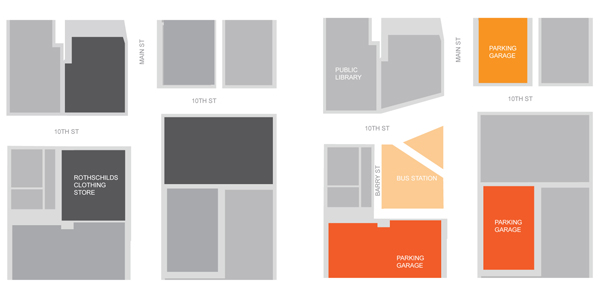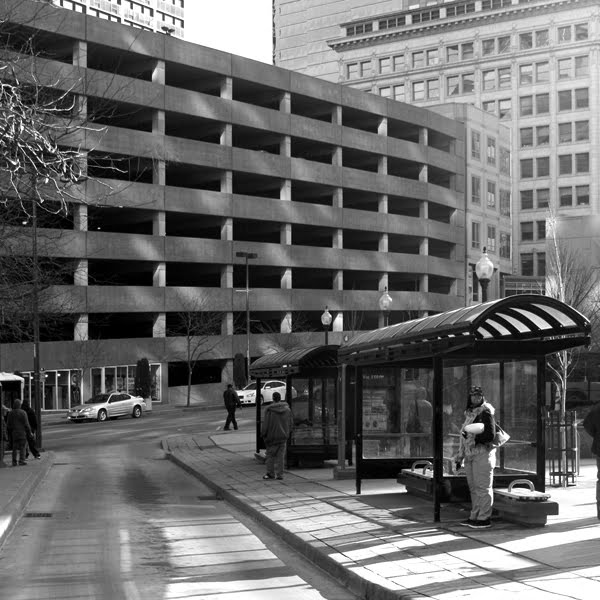>
A historically lively intersection sees new life as a center of transportation and informal gathering .
In the 1950’s the corner of 11th and Main enjoyed a busy street life, with many small-scale storefronts inviting pedestrians to walk about and shop. Like most Kansas City intersections, this site was responsive to conditions of local topography, with 10th Street dead-ending on either side of Main Street to navigate a steep hill. The offset intersection lent to a bottleneck of crowded activity.
While a fun place for socializing shoppers, the offset of 10th Street was not readily conducive to the easy flow of pedestrian and automobile traffic.
The intersection has since been reconfigured to allow for a more complex public transport system. The bottleneck has been opened, so 10th street proceeds uninterrupted across Main. The former site of Rothschild’s clothing store has been given over to waiting areas, drive-thru lanes, and drop-offs for citywide bus routes. Neighboring buildings, once lively with activity, have been demolished to provide quick-service retail, a pharmacy, and several parking garages. The corner is flanked by private office buildings, whose large marble lobbies are uninviting to the casual passerby, and the Public Library, which draws large crowds both inside and out.
….
Despite a seemingly negligent attitude toward pedestrian safety and public welfare, the intersection in its current configuration is a hotbed of activity, filled throughout the day with busy commuters, library patrons, and those looking for work. The space functions as an easily recognizable, and easily reached meeting place, where one can meet a friend, safe from the bustling traffic surrounding four sides of the intersection.
How can a space so clearly intended to be experienced in motion have such appeal to those needing a place to stay?
The nearby Public Library is part of the answer. Augmenting the transient public space with real amenities, like the café, restrooms, and internet access stations, the library allows a secondary cycle of movement in the space, from public exterior to public interior. Transitioning between the two, the plaza-dweller moves from a social space to personal space and back again. This cycle can be sustained indefinitely; one can spend entire days looking for work and reading while keeping a finger on the pulse of an ever-changing social circle.
The library is not the only piece of the puzzle, however, for this space is truly defined by that which it lacks. Circumscribed by multi-story parking decks and speeding city traffic, the space is devoid of any prescribed function, other than the support of mobility and transit. Such a space is easily appropriated for other uses, as mobility demands a vacuum, an open and smooth space free of impediment or obstruction of any kind. It is this openness that draws the plaza-dweller to the site, a field of limitless possibility and personal freedom in an otherwise regimented and precisely delineated urban realm. Dwarfed by the surrounding structures, and blurred by the speed of passing vehicles, the individual can be left surprisingly and pleasantly alone, simultaneously alienated and empowered by the modern city.
The new transit plaza is just as busy as the bottlenecked intersection used to be, and remains so throughout the day and seasons. No longer consigned only to shopping, the image of social and commercial life in the plaza is constantly in flux. Upon entering the transient space, the city dweller defines the space’s use anew, changing from hour to hour, and day to day. What appears an empty wedge in an empty downtown is surprisingly full of people and conversations, music and laughter.
This article originally appeared on kcfreepress.com.






